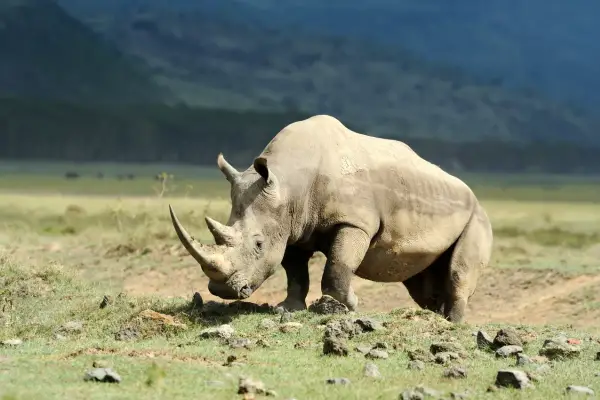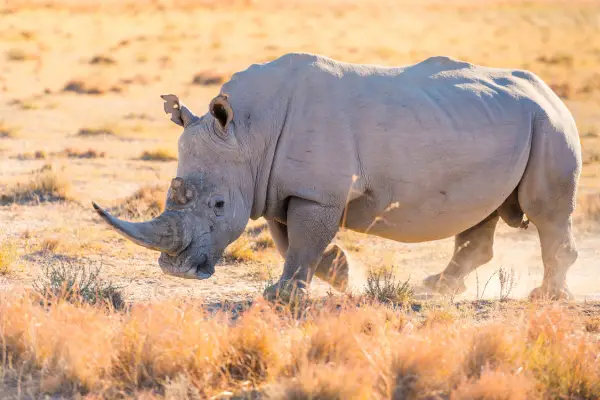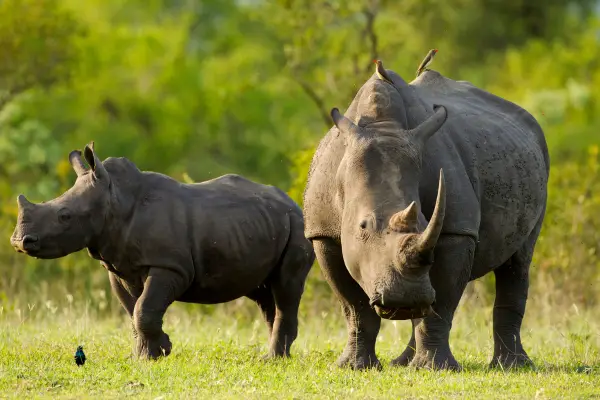The Crisis Facing Endangered Rhinos
The five rhino species alive today are some of the most threatened large mammals on Earth. Of the five, three are listed as critically endangered – just one step away from extinction, including the Javan, Sumatran, and black rhinos.
Sadly, current conservation efforts have failed to stop the dramatic declines in rhino populations over the last century, driven by poaching and habitat loss. As few as 67 Javan and 80 Sumatran rhinos survive today. But even white and greater one-horned rhinos remain endangered despite larger numbers.
All rhinos face an uncertain future and require drastically ramped-up protective measures if we want to conserve this iconic species.
The Dire Situation Facing Javan & Sumatran Rhinos
According to the latest IUCN Red List estimates as of 2020, just 67 mature Javan rhinos remain in the wild, all living in Ujung Kulon National Park in Java, Indonesia. This makes them possibly the rarest large mammal species after decades of hunting, habitat loss and natural disasters caused their population to collapse from an estimated 1000 individuals in the 1960s.
The 2020 eruption of the Anak Krakatau volcano highlighted their vulnerability when a resulting tsunami damaged park facilities, though miraculously, no rhinos perished. But with such tiny numbers, disease, natural disaster or increased poaching could easily wipe them out completely.
Sumatran rhinos face and equally perilous situation, with only around 80 individuals surviving today in fragmented small populations across Sumatra and Borneo. Intensive poaching and deforestation of their rainforest habitat saw the Sumatran rhino vanish from Thailand in 2008 and Malaysia in 2015.
The remaining wild rhinos in Indonesia now live in just two protected areas, Way Kambas and Bukit Barisan Selatan National Parks, though some may survive in unprotected areas. Lack of suitable habitat, more accessible forests for poachers and failure to breed successfully in captivity means time is rapidly running out for Sumatran rhinos unless more aggressive interventions take place.

Why Black Rhinos Remain Critically Endangered
The smaller of the two African rhino species, black rhinos once roamed across sub-Saharan Africa but saw their population plummet an estimated 97.6% between 1960 and 1995 to just 2410 individuals.
This catastrophic decline was fueled by rampant poaching to meet demand for rhino horn used as a traditional Chinese medicine and dagger handles in Yemen. Legal protections since then have aided black rhino numbers to increase slowly to around 5650 today, but the species remains listed as critically endangered on the IUCN Red List.
Even now, illegal poaching continues to hamper black rhino conservation efforts in African nations like Namibia, Zimbabwe, Kenya and South Africa. Over 500 black rhinos are still illegally killed each year to supply the persistent demand for rhino horn in Asian markets.
However, protecting these prehistoric survivors also faces challenges from loss of grassland habitat and increased human settlement expanding into their territory. Carefully managed conservancies, relocation to safer areas and dehorning are vital anti-poaching tactics, but all rhino range states need to share expertise and resources to secure the black rhino’s long-term survival.

Why White Rhino Numbers Don’t Ensure Safety
Contrasting with other rhino species, around 20,150 southern white rhinos survive in the wild today – hence why they’re classified as near threatened instead of endangered. But although concentrated in South Africa’s conservation areas, even the white rhino is far from safe.
Shocking recent incidents include the slaughter of a record 453 rhinos in Kruger National Park in 2021 as poaching pressure remains intense in strongholds like South Africa’s famous game reserve.
Poaching gangs have decimated white rhino numbers in other southern African countries like Zimbabwe where populations plunged 90% since 2007, while illegal rhino horn syndicates have emerged across Europe and Asia.
Legal trophy hunting also impacts southern white rhino conservation, while lack of genetic diversity threatens the survival of small, isolated northern white rhino groups in Kenya and Uganda. Just two elderly northern white females now survive under armed guard, but cutting-edge IVF treatments using stored frozen sperm, eggs and tissue offer a $20 million last chance to ‘resurrect’ the subspecies.
Global Collaboration & Innovation Needed to Save All Rhino Species
All five rhino species have seen populations decimated mainly due to poaching to meet demand for rhino horn, destroying decades of conservation efforts. Many wildlife charities and national parks now use increasingly sophisticated intelligence gathering, detection technologies and rapid response teams to catch the organized criminal networks driving illegal rhino killing. But huge challenges remain to prosecute high level wildlife traffickers while disrupting the rhino horn consumer market.
Conservationists also emphasize the need for more multi-national collaboration between rhino range states to share law enforcement tactics, population data, breeding techniques and habitat management policies. Beyond boosting security patrols and dehorning programs, cutting-edge IVF treatment shows promise for boosting rhino birth rates while pioneering approaches like creating fake horns could undermine poaching incentives.
But increased political will and public awareness are urgently needed to fund such innovative programs if we stand any chance of turning around the drastic declines of all rhino species for the long term.
FAQs:
How many species of rhinos are there?
There are five species of rhino still in existence: white rhino, black rhino, greater one-horned rhino, Javan rhino and Sumatran rhino. Of these, the Javan, Sumatran and black rhinos are critically endangered.
Why are rhinos endangered?
The main threats facing all rhino species are poaching for their horns and habitat loss. Rhino horns are highly valued in traditional Asian medicine and dagger handles in the Middle East, fueling an illegal multi-million dollar wildlife trade. Deforestation and human settlement expansion also destroy the grasslands and rainforests rhinos depend on.
How can we save rhinos from extinction?
Key rhino conservation measures include strict protection against poachers through security patrols, intelligence gathering and specialized technologies. Managing protected sanctuaries, breeding programs and relocating rhinos to safer areas also helps expand populations. There is also more focus on prosecuting high-level wildlife traffickers and rhino horn consumers in Asia.
Which country has the most rhinos?
South Africa has the world’s largest rhino population with around 19,000 white rhinos and 1,600 black rhinos. Other key rhino range states are Kenya, Namibia, Zimbabwe, India, Indonesia and Nepal.
Are rhinos smart animals?
Yes, rhinos are highly intelligent animals. They have an excellent sense of smell, detect each other by their scent and communicate through smells, sounds and touch. Mother rhinos form strong social bonds with their young who stay together for 2-3 years until the next calf arrives. White rhinos have also shown problem-solving abilities and memory retention.


